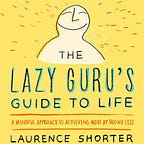The Liberation of Doing Nothing — Wittgenstein and Neural Pathways
I once heard a story that the philosopher Ludwig Wittgenstein was walking down the road in Cambridge when his sister spotted him out of a window. She said later of this moment: “My brother was leaning forward as he walked, as if he were pushing against a strong wind. But it was a completely still day. The wind was inside him.”
This story, apocryphal or not, made an impression on me as a metaphor for inner intensity. I also feel often as if the forces inside me — whether feelings, ideas, needs, desires or frustrations — are stronger and more compelling than the inconveniences of the outside world. It seems as if my real task in this life is get them into agreement, settle them down, detach myself from them so that I can harness them to good use — and get to work.
How does one do that?
There are many ways to change behaviour, from therapy and NLP to meditation and spiritual practice. All these things can work, but my experience tells me there is something that precedes the action of change, something simpler — like gentleness… or nurturance.
Which brings me onto my current interest in neural pathways. I’m going to drop another quote on you, this one from the erudite blogger Zat Rana:
“In modern psychology, the concept of the modularity of mind… suggests that we have different neural modules in the brain that are sometimes in conflict with each other. Some modules want one thing, whereas different ones want another.”
The concept of inner winds has a neurological counterpart. It’s scientific, innit?
The idea that habits are hard wired rings true to me. I find it easier to drink a coffee than to change my life so that I am more energised by what I do. I find it easier to check my phone than not to check it. I have awkward habits around decision making that have lasted decades.
The catch is, these so-called ‘bad habits’ often create an equal and opposite neural pattern called a ‘should’. I shouldn’t do this, I’ve got to stop, this is bad. This ‘should’ complex is not generally an enlightened companion but rather a part of the problem: the vibe is worried, self critical, stress-creating. Rather than changing behaviour, it entrenches it, kind of like when you tell a toddler off for throwing food.
All this needs to relax and unwind. The contradictions and dissatisfactions inside us need to be given space to chill out and sink back into their home in flesh and bone. Instead of letting them light up your neural pathways and taking action that may be suboptimal, you can lie down and do nothing for a while.
Hence the art of ‘having no idea’.
The No Idea practice is a journey into rewiring habitual behaviours that don’t serve you anymore, not by self-manipulation or practices of self-denial, but through relaxation and radical okay-ness.
This is how it works:
- Once a day, sit or lie down somewhere comfortable
- Set your timer for 10–20 mins
- Do nothing
If you can do this regularly, you will find your work nourished, your life calmer and your inspiration flowing more freely.
